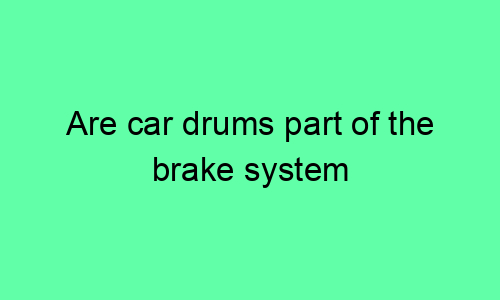## Are Car Drums Part of the Brake System?
### Introduction
When it comes to automotive braking systems, there are two main types of components: discs and drums. While both serve the same purpose of slowing or stopping a vehicle, they operate in different ways and have distinct characteristics. This article will delve into the topic of car drums, exploring their role in the brake system, their construction, advantages, and disadvantages compared to disc brakes.
### Construction of Car Drums
A car drum is a cylindrical metal part that rotates along with the wheel. It consists of two main components:
– **Drum lining:** This is a friction material bonded to the inner surface of the drum. When the brakes are applied, the brake shoes press against the drum lining, creating friction that slows or stops the wheel.
– **Wheel cylinders:** These are hydraulic cylinders located inside the drum that contain pistons. When the brake pedal is depressed, brake fluid is forced into the wheel cylinders, pushing the pistons outward to force the brake shoes against the drum lining.
### Role of Car Drums in the Brake System
Car drums play a crucial role in the braking system by converting hydraulic pressure into friction. When the brake pedal is pressed, it activates the master cylinder, which creates hydraulic pressure in the brake lines. This pressure is transferred to the wheel cylinders, which in turn push the brake shoes against the drum lining. The friction generated between the drum lining and the brake shoes decelerates or stops the vehicle.
### Advantages of Car Drums
Car drums offer several advantages over disc brakes, including:
– **Lower cost:** Drums are generally less expensive to manufacture and replace compared to discs.
– **Reduced weight:** Drums are lighter than discs, which can contribute to improved fuel efficiency.
– **Self-adjusting:** Some drum brakes have self-adjusting mechanisms that automatically compensate for wear and tear on the brake shoes, ensuring optimal performance.
– **Less prone to corrosion:** Drums are less exposed to the elements than discs, making them less susceptible to corrosion.
– **Suitable for heavy loads:** Drums are particularly effective in heavy-duty applications, such as commercial vehicles and off-road vehicles, where high braking force is required.
### Disadvantages of Car Drums
Despite their advantages, car drums also have some disadvantages:
– **Lower braking performance:** Drums generally provide less braking force than discs due to their smaller contact area and less effective heat dissipation.
– **Slower cooling:** Drums have less surface area for heat dissipation, which can lead to overheating and reduced braking performance under sustained use.
– **Prone to fading:** Drums are more prone to brake fade, a phenomenon where the braking performance deteriorates as the brakes overheat.
– **Water and dirt susceptibility:** Drums can be affected by water and dirt, which can reduce their effectiveness.
– **More complex assembly:** Drums require more components and assembly steps compared to discs, which can increase maintenance costs.
### Comparison of Disc Brakes and Drum Brakes
| Feature | Disc Brakes | Drum Brakes |
|—|—|—|
| Construction | Rotor (flat disc) and brake caliper | Cylinder (drum) and brake shoes |
| Braking force | Higher | Lower |
| Heat dissipation | Better | Poorer |
| Cooling | Faster | Slower |
| Brake fade | Less prone | More prone |
| Assembly | Simpler | More complex |
| Cost | Higher | Lower |
| Maintenance costs | Lower | Higher |
| Wet weather performance | Better | Poorer |
| Suitable applications | High-performance vehicles, passenger cars | Heavy-duty vehicles, commercial vehicles, off-road vehicles |
### Conclusion
Car drums are an essential part of the brake system, playing a vital role in converting hydraulic pressure into friction to slow or stop a vehicle. While they offer advantages such as lower cost and reduced weight, they are generally less effective in braking performance and cooling compared to disc brakes. The type of brake system used on a particular vehicle will depend on the specific requirements and application.






